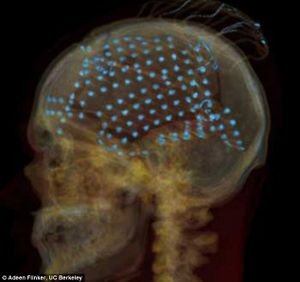Translate brain waves into words
Scientists have also discovered how to 'translate' brain waves into words ... see Can a machine read your deepest thoughts
For centuries, humans' goal was to see the mind in our brains - and it is now available in science fiction movies with low budgets.
Now, reading the mind's machines is about to move from realms of fantasy to reality. A team of scientists announced this week that they have developed a technique that allows them to read our minds. In an unusual experiment, the researchers recorded complex patterns of electrical activity in a person's brain
By feeding those mental patterns in the computer, they were able to translate them back into actual words - the same words that the volunteer had listened to.
Scientists behind the work believe that they can now go beyond that and read ideas in the brains of people and did not disclose them using electrodes placed in the brain
It's an amazing development that can have tremendous effects. Doctors can someday allow patients who have fallen by strokes or brain damage to communicate through the power of thought. Judges can use mind reading machines to find out if the suspects are killing the truth.
That these kinds of breakthroughs change the lives of millions of people around the world. But it raises the possibility that mind reading devices can be used to secretly eavesdrop on most of our own thoughts and dreams
The latest experience was conducted on 15 patients treated at the hospital from the treatment of epilepsy. Their treatment, as the doctors concluded, included removing a quarter of the skull and placing a network of micro electrodes directly on the brain, and then temporarily restoring the skull. Doctors want to use electrodes to determine where they are responsible within parts of the brain for seizures, so they can remove target tissues
Because epileptic seizures are unpredictable, patients sometimes have to wait in the hospital with the electrodes in place for several days until they have other seizures. While they were waiting, a team of researchers at the University of California, Berkeley, asked 15 of them to take part in an experiment to read the mind
Our brains are extraordinary things. Each group is from 100 to 200 billion neurons or neurons, while each of these neurons is linked to between 7,000 and 20,000 other neurons. There are more connections between the neurons in the human brain than the number of stars in our galaxy
Neurons pass information to each other using small electrical currents. This is the cumulative effect of these small sparks that form the electrical activity of the brain
Scientific breakthrough: The X-ray scan of the head of one of the volunteers, showing the electrons distributed on the temporal lobe of the brain, where the sounds are processed
In the experiment, each patient listened to the recorded words for five to ten minutes, while the network of electrodes placed under the skull monitors activity in the part of the brain connected to the speech comprehension called the Vernier region
The brainwave data was fed into the computer, which looked for links between individual sounds and distinct patterns of electrical activity. The computer was able to translate certain patterns of brain activity into words

The researchers, led by Dr. Brian Beasley, tested the computer by injecting a new set of words into patients.
It is conceivable that (reading the mind) in the next ten years can become a reality. I think it's a matter of when and not if, but at the moment the technical difficulties are very large, "Jean Chenop, professor of neuroscience at Oxford University
Again, I found contacts. Time after time - and with miraculous precision - the computer was instantly able to recite words read in the brain waves of volunteers, words like 'Waldo', 'Structure', 'Doubt' and 'Property'. The next step for the team is to see if the technique works when the volunteers imagine the words themselves - rather than just hearing them read.
Dr. Paley believes that it will be possible within a few years to lead to a device that can be implanted in the brain for stroke patients or victims of brain damage cells that are "reading" their thoughts and talking with them aloud to them.
John Chen op, a professor of neuroscience's at Oxford University, admits that what is being admired.
"They've taken a big step here, but there's a long way to go before you get the proper mind reading," he says. "It is conceivable that in the next ten years this could happen. I think it's a matter of when and not if, but at the moment will bring up very great technical difficulties

If you allow me for a comment, in addition to this excellent post, it could be cool to add some references or sources, no? Thanks in advance for your consideration :)
thank you my friend
Hi @mars9 my friend. Excellent post!
This is really good news when it comes to technology like the neural lace. That would be very useful however if you were to add a source or two to this post. I actually wrote a little about the possible affects of a neural lace technology on society here:
https://steemit.com/sciencefiction/@digitalcosmos555/futurtopia-1-neural-lace-how-society-will-change
Maybe they can apply this technology to the millennial generation.
Congratulations for the quality of this work dear friend @ mars9, thank you very much
very cool. I appreciate this share. :-)